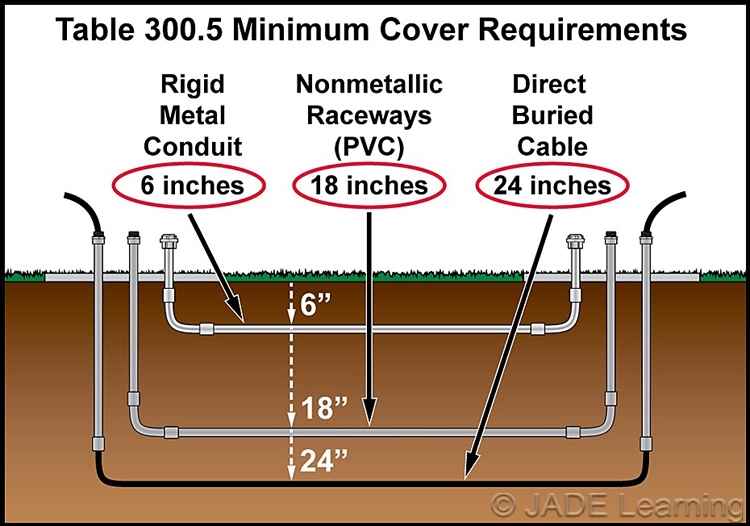Electrical Burial Depths and Procedures

By: Dave Varga | Mar 02, 2021
Underground electrical installations can save labor hours, material costs, and provide protection to the installation. Sometimes going underground is the only logical path to get service from one point to another whether new construction or remodel work. Overall, there are not many electrical projects that don’t require a little digging in the dirt at some point. Let’s dust off the National Electrical Code (NEC) and review some Code pertaining to burial depths and standard operating procedures.
Before You Dig
An installation may be originating from a transformer or even another electrical panel. For many reasons it’s best to go as straight as you can from point A to point B. Review the area to determine the best path and then mark the path with spray paint. Call 811 before you dig! You must call at least two full days before you plan on digging so the local utilities have time to mark their locations. The last thing you want to do is hit a utility and be liable for the damages. Even a homeowner installing power to the shed in the backyard must call before digging. Hand digging at depths up to 12” may be permissible, but call 811 for their guidance first. It’s a good idea to keep track of the weather forecast so you can plan your digging and underground inspection for good weather. Also, don’t forget to reserve any needed rental equipment many days before your dig.
Residential Installation Burials
Some typical residential installations would include various sizes for PVC and direct burial cables. Article 300,
 General Requirements For Wiring Methods And Materials, will cover most of the installation Code requirements. The focal point of this section will be Table 300.5 Minimum Cover Requirements, 0 to 1000 Volts, Burial in Inches. On the left side of the table there is a column marked Location of Wiring Method or Circuit. For a one- or two-family dwelling location use the appropriate column as noted. Use the top of the table to select the Type of Wiring Method of Circuit. Once you know your wiring path or location and your wiring method, you can now use the chart to determine the depth of your trench. See Note 1 below the Table. The depth of your trench is actually the distance from the top surface of the finished grade to the top service of your direct-burial conductor, cable, conduit, or other raceway.
General Requirements For Wiring Methods And Materials, will cover most of the installation Code requirements. The focal point of this section will be Table 300.5 Minimum Cover Requirements, 0 to 1000 Volts, Burial in Inches. On the left side of the table there is a column marked Location of Wiring Method or Circuit. For a one- or two-family dwelling location use the appropriate column as noted. Use the top of the table to select the Type of Wiring Method of Circuit. Once you know your wiring path or location and your wiring method, you can now use the chart to determine the depth of your trench. See Note 1 below the Table. The depth of your trench is actually the distance from the top surface of the finished grade to the top service of your direct-burial conductor, cable, conduit, or other raceway.
With that information the proper depth trench can be made, wiring method installed, and inspection called in. Once the inspection is passed, you can begin the backfill process (see 300.5(E)) and install a warning ribbon if dealing with service conductors (see 300.5 (D)(3)). Pay close attention to Article 300.5 and make sure the correct conductor is selected for the location. Below are just a few examples of common residential installations and burial depths.

| Type of Wiring Method | Location | Burial Depth |
|---|---|---|
| 120 volt, 20 amp, UF cable | Dwelling, front yard | 12″ |
| GFCI Protected Circuit | ||
| 220 volt, 30 amp, direct burial cable | Dwelling, back yard | 24″ |
| 30 volt, listed landscape cable | Dwelling, yard area | 6″ |
Commercial Installation Burials
The same basic procedures and codes above also apply to commercial installations. Use Article 300 and Table 300.5 again as needed. The commercial wiring methods used would mainly be PVC and rigid metal conduit. The biggest differences between a residential site and a commercial site is going to be types of locations encountered and burial depths. A commercial site can encounter installations under buildings, under concrete slabs, under parking lots, and even airport runways. An underground electrical service underneath a parking lot would need to be buried at a depth of 24” no matter what type of wiring method was used. An installation in PVC under a building’s concrete slab would basically have no burial depth. If your location of wiring method or circuit is not specified, then use the top row of Table 300.5 labeled “All locations not specified” or contact the local AHJ for clarification. Below are a few examples of common commercial installations and burial depths.
| Type of Wiring Method | Location | Burial Depth |
|---|---|---|
| 600 volt, 1200 amp, PVC | Alley | 24″ |
| 277 volt, 30 amp, PVC | Under a building | 0″ |
| 480 volt, 60 amp, Rigid Metal Conduit | Outdoor seating area, 4” slab | 4″ |
Know the Code
As an industry professional you must know the National Electrical Code (NEC) well and basic industry standards. You will save a lot of time and money by doing the job correctly the first time. Keep learning and continue your education at www.jadelearning.com



I need to know the spacing of dirt material required to separate electrical commercial line and a gas line????
NEC does not mandate this requirement
this need to be followed as per local building code, and AHJ for spacing
Home owner needs power to a free standing garage built in 1921. Gas. Electric, phone, and water have been out and marked the grounds . There are no marking in the back yard. Anything more that I need to do to have a trench dug for Electric out to the garage.